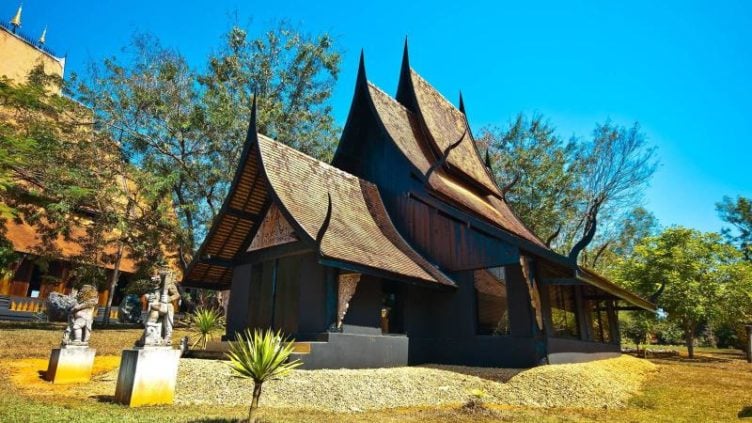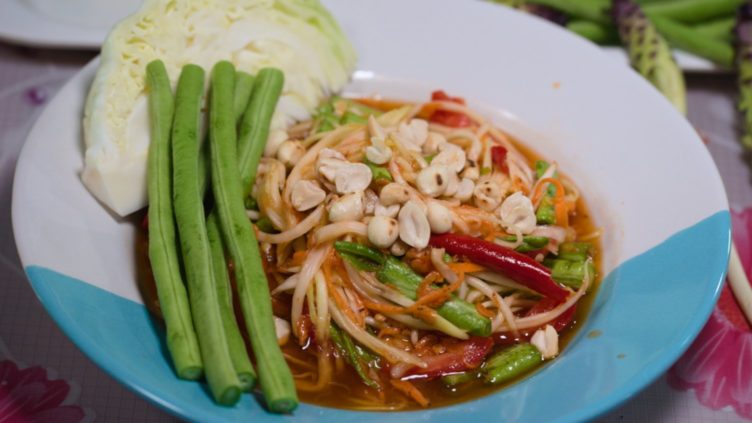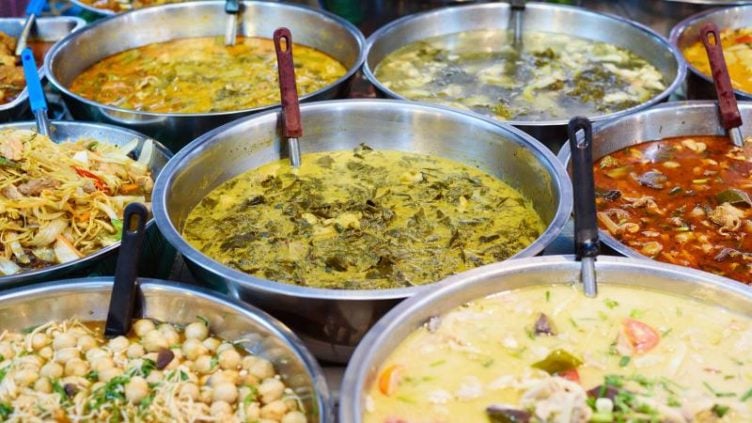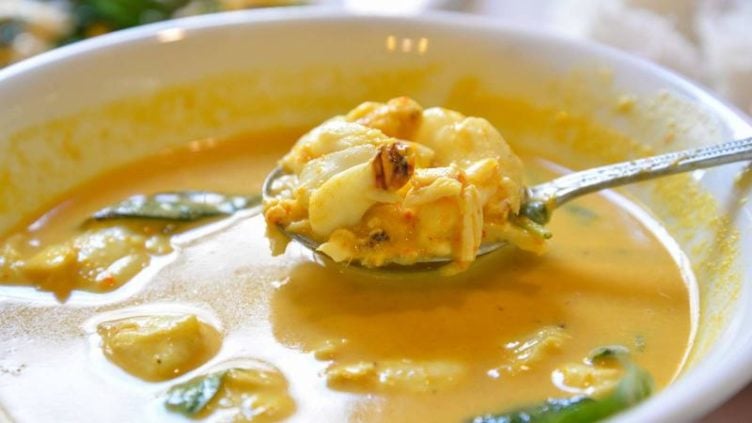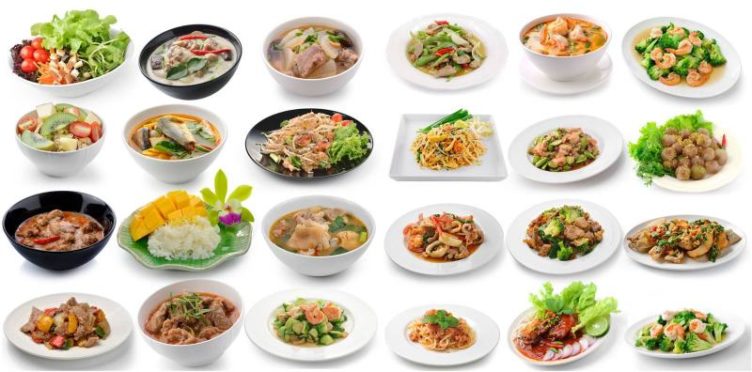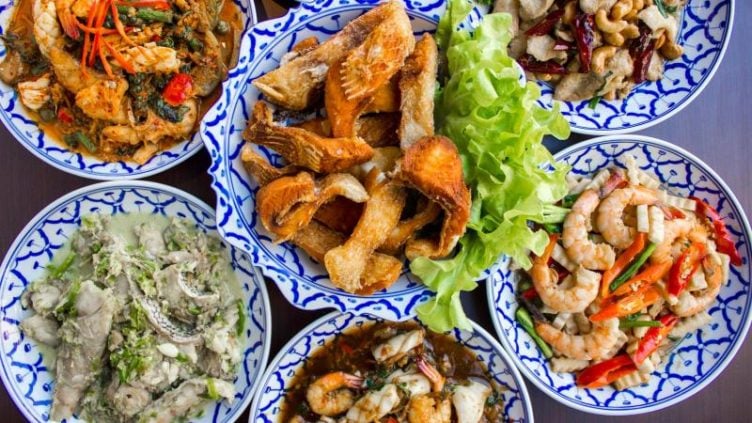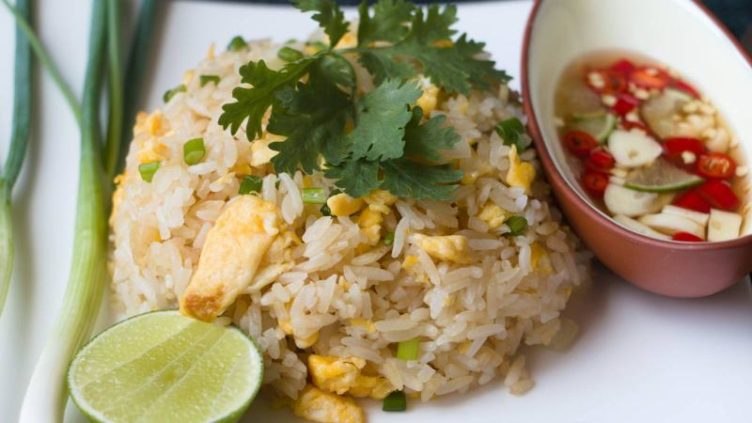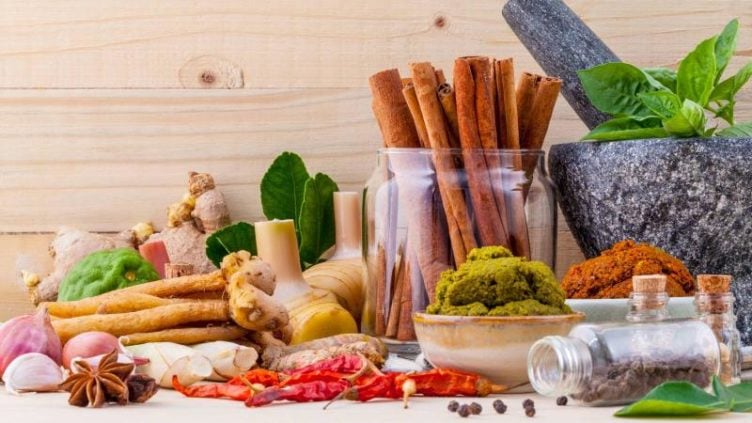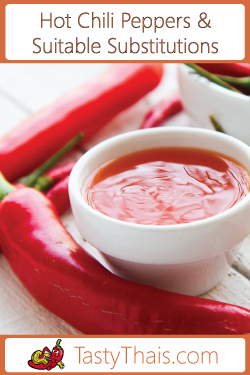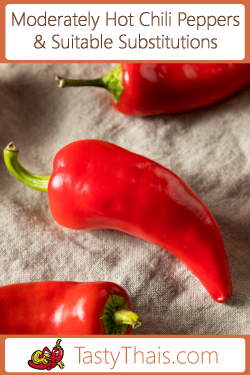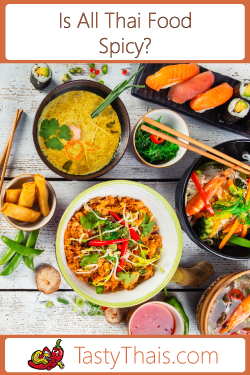Thailand likes to identify itself as the land that has never been colonized, which may be so, but in reality, Thailand is a mish-mash of various races that have migrated over the centuries. A mix that makes up the Thai people of today.
This mix has influenced the culinary culture to bring a wide range of dishes that make up the world of Thai Food.
What is Thai Food?
Thai food encompasses a wide range of styles from bbq to stir fry, curries to spicy salads, soups to steamed dishes and porridge to crispy insects. Thai food usually has a blend of sour, sweet, salt, and savory tastes plus heat from chilis.
Some dishes add a creamy consistency from coconut milk. these tastes are carefully blended to get the perfect balance to serve every taste your tastebuds can sense.
Learn more about how the various flavors of Thai food here – we think you’ll find it interesting. And if you are new to Thai cooking and want to try cooking it, grab our shopping list of essential Thai Food Ingredients and some special Thai cookware it might be worth investing in.
Thailand is not homogenous in a culinary sense (and the people from different regions differ quite a lot too). Much like most countries, there are regional differences with the Northern Thai people quite different in their culture to the Southern Thai people.
What is Thai Cuisine?
Internationally, Thai cuisine encompasses each style of food combined together from each of the regional types of cooking as well as the Royal Thai cuisine made popular by recipes devised by the royal chefs.
Thailand has seven distinct Thai cuisines, mostly regional in nature. Northern Thai (Lanna), North-Eastern (Isaan), Eastern, Central Plain, Bangkok, and Southern. Then a cultural cuisine which is Royal Thai cuisine – responsible for many recipes featuring coconut milk and expanded later in this article.
When taken together these regional cuisines are typically lumped into the term “Thai Food”
Assuming we have some basic experience of the food eaten in a given geographical area eg. then we instinctively have a sense of the essence of that cuisine. Even though every cuisine has elements of other cuisines as part of it, it is the interaction and balance into the whole which identifies a particular cuisine.
Developing that idea further we have regional cuisines as well as cultural cuisines that form part of those. As an example, Phuket has a large number of people who eat vegetarian or “Jae” food and have a festival dedicated to it as well. Hence a number of localized and specialized vegetarian dishes most common on the island.
Thai Food IS Thai cuisine from an international perspective but within Thailand, the meaning of Thai food will change according to your location and its particular local cuisine at the point of conversation.
The area in and around Bangkok is a mix of people from all over Thailand and beyond attracted largely by prosperity.
This gives Bangkok its own personality and over the years Bangkokians have developed a sort of haughtiness that comes from their attempt to differentiate themselves apart.
Northern Thailand – The Beginnings of Thai Culture
Perhaps, Northern Thailand is the real origin of Thai people as the tribes in the area around Chiang Mai came together as the Lanna Thai – a federation of tribes and rulers.
The people migrated south to Sukhothai, now called Ayuthaya, where the people consolidated under a single King – King Sri Indraitya in the mid 13th century – a dynasty that lasted until the mid 18th century.
That dynasty was followed by Taksin the Great in the Thonburi dynasty that lasted only 14 years when Sukhothai was sacked by invaders. He was quite a warrior as well as a statesman building infrastructure, encouraging education, art, and culture and fostering foreign relations as well as restoring temples.
King Thaksin the Great was succeeded by Chakri dynasty – the current dynasty – which moved the capital to Bangkok where it remains today.
Northern Thai Food
Northern Thailand people are descendants of peoples from tribes in Laos, Cambodia, and Myanmar. Those in the northern part of northern Thailand mostly influenced by Laos, those in the western part mostly influenced by Cambodia and those in the west more by Burmese.
From a culinary point of view, there are distinct variations in local dishes in the various areas of Northern Thailand.
Khao Soi, for instance, is a particular dish of Burmese origin very popular in northern Thailand.
Woonsen is an import from Chinese traders popular in the region. These transparent noodles made from mung bean starch are a popular base for Northern Curries, soups and stir-fries.
Sticky rice is grown predominantly in the North and so is the preferred rice to eat, rolling it into balls with the hands to soak up the juices of the dishes or coating it with butter, frying it, and eating it as a snack.
Nowadays there is more Jasmine Rice grown in the region as the farmers can get better prices for the crop but sticky rice persists as the traditional carbohydrate to eat and the poorer people generally still eat with their hands at home.
Naem (fermented sausages) and Pla Ra (fermented fish) is a familiar ingredient in Isaan dishes with Pla Ra having a somewhat stomach-turning smell idolized by Isaan people, perhaps as a unique identifier?
Som Tam Poo Pla Ra is a typical example of a hugely popular dish from northeast Thailand that Isaan people just adore, almost universally. It is basically a traditional Som Tam Thai with fermented crab added that gives it its uniqueness that some love and others really loathe.
Central Thai Food
Central Thailand has assembled its own set of dishes that epitomize the plains area and Bangkok which is the hub of everything.
Jasmine Rice (Hom Mali) is the predominant rice crop of the region and is widely the type of rice eaten in all by the poorest households. Jasmine Rice is also known as fragrant rice because of its delightful smell and is significantly more expensive than the cheaper sticky rice of the Northeast.
Dishes made with coconut milk are common in the Central Region, where Thai recipes concocted by the Royal cooks had significant influence with the coconut milk based Thai curries originating here.
Bangkok has seen a huge influx of people from all over Thailand searching for work and money along with traders from the West, Chinese and people from the adjoining countries. Lately, Western fast food, Italian and Indian food has flourished with the result that you can find just about any food in Bangkok.
Thai food still predominates with street food vendors who have arrived from all over the country peddle their own form of Thai cooking at cheap prices and generally pretty good quality. Perfect food for hungry yet still relatively poor workers to grab at lunch or on the way home.
Street food in Bangkok is still fantastic even though, more recently, under fire a little by the government that is attempting to clean up the streets by limiting the areas that vendors can sell in.
Many Thais live in very basic accommodation that consists of little more than one room and even middle-class Thais may live in quite cramped conditions because of the high property prices in the capital. Awful traffic congestion driven by the Thai love affair with the motor car mean that living further out where the property is cheaper, is not always very practical.
These factors are the driver of street food with a large proportion of Thais eating out rather than cooking at home and kitchens are very much an optional extra in the average home and very basic.
It is just cheaper and easier to eat out with the added benefit that the living accommodation is not polluted with the smells and airborne oil that comes with a lot of stir fry.
Bangkok has quite a number of Korean and Japanese restaurants because quite a lot of Korean and Japanese have settled in Thailand.
The Chinese are the biggest immigrants to Thailand and Thai-Chinese dominate the richer sections of society now. Along with their influx comes their food with dumplings, sweet and sour dishes and dim sum commonly found even in quite ordinary Thai eateries.
Southern Thai Food
From the South, there is more influence from the Malays with curries and seafood the main focus.
If you look at a map of Thailand you will see that the long southern section has most of the south close to the sea no matter where you live since the distance from the beach to the border with Myanmar is short.
With so close a proximity to the sea, it is no wonder that much of the southern Thai cuisine is seafood-based.
Typical Thai Meals
There is really no such thing as a typical meal although there are a number of very commonly eaten dishes.
You can segregate Thai food into three main types leaving aside very hi-so banquets for a moment.
Thais are quite social people because making contacts that can help you and having as wide a circle of ‘friends’ is seen as beneficial.
Marry the penchant for eating out and the benefits of a wide circle of friends and fairly cheap restaurants and you will find it unsurprising that Thais quite often gather together as groups within their circles to eat – and make new friends.
It is usual for the diners to order dishes and for these to be spread across the table for all to share. It is a stark contrast to the Western practice of ordering the food you want to eat and for each individual to eat what they ordered.
This social eating is one type of dining where a wide range of food and side dishes are there for the tasting.
These meals usually incorporate five main types of dish.
A starter snack, maybe roasted cashew nuts with chili or sun-dried beef or pork.
A soup such as Tom Yum Goong or the milder Tom Kha Gai
Rice and several plates of food to be eaten with it such as a curry dish, stir fry dish, maybe a deep-fried fish or squid dish often accompanied by a mango or papaya salad (such as som tam Thai).
A bowl of raw vegetables including cabbage and cucumber as well as herbs and spices such as chopped or dried chili, sriracha sauce or sweet chili sauce along with several dipping sauces to eat along with everything.
There will be water and often beer to swill it down and fresh fruit or some form of sweet dessert to finish – although this is often skipped.
The second type of eating is seen at lunchtime. As time is too short for a big meal, smaller groups of a few people will go to a restaurant and order a quick meal to eat. These dishes tend not to be shared and are usually single plate meals or a plate of rice with a spoon of food from two or three large pots of pre-prepared dishes.
These single plate meals like egg fried rice or khao mok gai are enough to take you through to the evening and are quite filling.
The pre-prepared dishes range widely from boiled eggs to soups, grilled meat or fish and stir-fries such as pad krapao gai. Noodle based dishes and curries such as Pad Prik King and Massaman are also common.
The defining feature is that you can turn up, order and within moments have a filling and taste-filled plate of food with no time wasted.
The third type of eating is a person alone grabbing a quick snack to eat on the go – often a pancake or patty, or skewer of grilled meat or squid and a whole lot more.
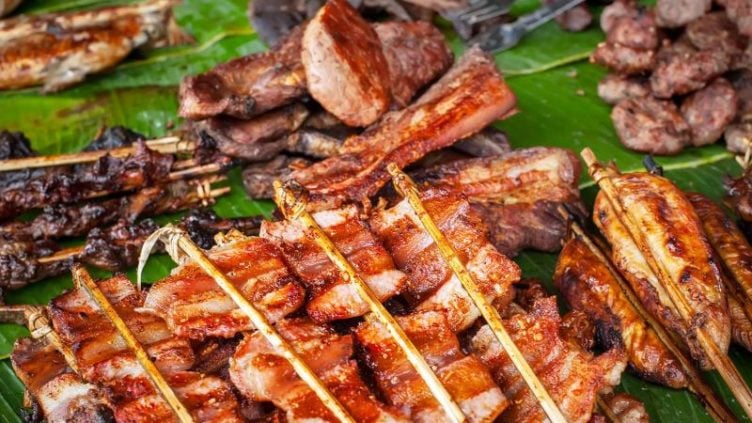
Typical Thai Ingredients
There are hundreds of ingredients used in thai cooking but some a less common than found in other cuisines. Basic transliterated Thai words in brackets.
Holy Basil (bai grapao) – a herb that is often eaten raw or added at the end of cooking to give off a wonderful aroma and taste eg. Pad Grapao (meaning fried with basil)
Lemongrass (takhrai) – another aromatic herb used in many dishes as well as drinks and either crushed or thinly sliced to add aroma and taste eg. Tom Yum Kung (famous Thai soup featuring lemongrass)
Galangal (kha) – Another common ingredient used to flavor and seen in many, many dishes eg. Tom Kha Gai (Mildly spicy Thai coconut soup)
Chili (prik thai) – the hot Thai chili used in most dishes somewhere in some form. Comes as dried whole chili used in soups and curries, thinly cut slices as a side condiment or in fried rice and many other dishes, and dried chilli flakes (prik haeng) used to adjust spiciness. eg. too many dishes to mention
Spur Chili (prik chi fha) – sliced diagonally but much milder than Thai chili and used to color more than add spice eg. panang (curry dishes)
Garlic (gratiem) – used in a vast variety of Thai dishes chopped, crushed, grated and whole. Widely used basic ingredient
Lime (manao) – used to add citrus sourness to balance the sweetness. A widely used basic ingredient
Palm Sugar (namtarn palm) – used as the go-to sweetener in preference to western-style refined sugars and tastes way better! A widely used basic ingredient
Soy Sauce (nahm tua leung) – used as an umami or savory flavoring eg. pad see-ew but a widely used basic ingredient
Fish Sauce (nam pla) – strong salt taste used in preference to refined salt eg. goong share nahm pla (raw shrimp in fish sauce with garlic and bitter gourd) but a common basic ingredient
Pandanus Leaves (bai toey) – mildly aromatic thin leaf eg. hor mok talay (southern curried dish cooked in pandanus leaves
Banana leaves (bai tong) – used for packaging up and often kept together with a toothpick eg. hor mok (packaged southern curry)
Banana Flower (dok gluay) – eaten as an ingredient in southern salads or soups
Coconut Milk (krati) – very widely used in soups and curries from the central region as well as sweet dishes eg. Pumpkin in Coconut
Kaffir Lime Leaves (bai makrud) – used to flavour soups and eaten if finely shredded eg. panang curries
Long Green Beans (tua fak yao) – eaten raw as a salad vegetable and used as an ingredient eg. som tam (spicy Thai salad)
Round Eggplant (makhuea suai) – eaten raw as a salad vegetable and extensively used in soups and curries eg. kaeng kieow wan (green curry)
Young Bamboo Shoots (Nor Mai) – used in curries eg. kaeng nor mai gai (Chicken & Bamboo shoot curry)
Chinese Kale (pak kha na) – cooked as a vegetable and cut up for use in many dishes eg. pad pak kha na goong nahm hoi (stir fried chinese kale in oyster sauce with shrimp)
Morning Glory (pak bung) – usually stir-fried along with garlic and chili eg. pak bung fai daeng (literally red fire morning glory)
Fingerroot (krachai) – sliced up thinly in various dishes with a slightly similar taste to root ginger eg. pad prik king moo (Stir-fried pork with chili and fingerroot)
and many many more.
I hope you found a few ideas to try. If you have any questions then please leave a comment and I’ll do my best to answer them. Also if you have any recipes you’d like me to cover then be sure to let me know also.
Other Recipes You Might Enjoy:
